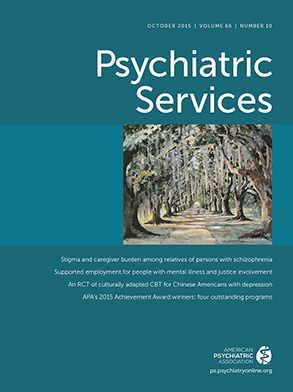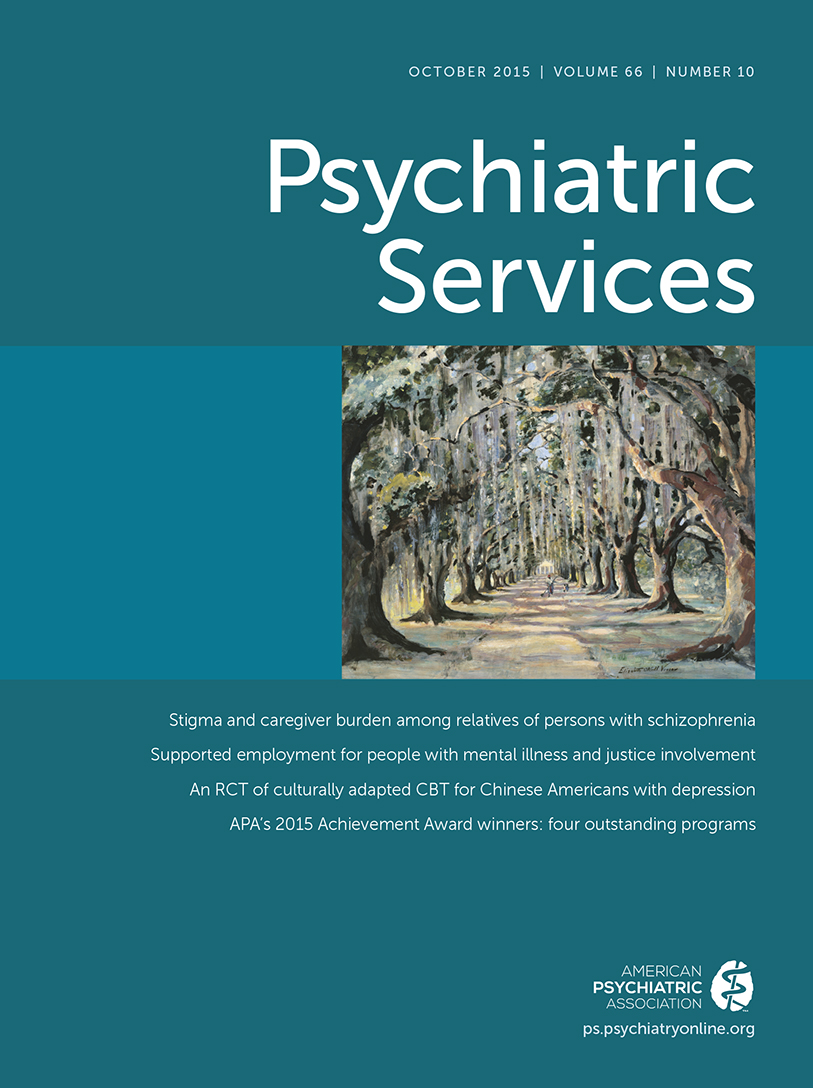The Medicare prescription drug benefit (Part D) relies on private market mechanisms to deliver care. As of 2009, a typical beneficiary could choose from between 45 and 57 private, stand-alone Part D prescription drug plans (PDPs), depending on the beneficiary’s region of residence. It is known that beneficiaries do not choose plans based on their medication needs (
1) and that the ability to choose plans is poorer among beneficiaries with mental disorders (
2).
The prevalence of schizophrenia is about 2.6% among Medicare beneficiaries enrolled in PDPs, much higher than the 1.1% in the U.S. general population (
3,
4). In addition, most PDP enrollees with schizophrenia are eligible for the Medicare Part D low-income subsidy (LIS) program, which provides substantial premium and cost-sharing assistance to beneficiaries who qualify (
5). About 93% of PDP enrollees with schizophrenia received the subsidy in 2007 (
3), compared with 40% among all PDP enrollees (
6). The LIS program covers an LIS enrollee’s premium up to a benchmark amount, which is calculated for each of the 34 PDP regions on the basis of the average premium bid for the basic benefit offered by PDP and Medicare Advantage Part D plans (
5).
To avoid discontinuation of drug coverage, especially among those who also qualified for Medicaid coverage and therefore obtained their drug coverage through Medicaid before implementation of Part D, most LIS enrollees were randomly assigned to a benchmark plan in 2006. Once assigned to a Part D plan, LIS enrollees can switch plans at any time. LIS enrollees can choose to enroll in any Part D plan and pay any extra premium above the benchmark amount (
5).
Random assignment does not assign enrollees to plans based on their medication needs, which has caused severe problems, including disruptions in plan coverage for 5.9 million beneficiaries between 2007 and 2010 (
5,
7) and high beneficiary and government spending for those assigned to plans requiring high copayments (
8). Patients with schizophrenia may be affected even more than other beneficiaries, because the average drug expenditures per year of those with schizophrenia exceed $7,000, much higher than the $1,600 for an average beneficiary and the $3,600 for an LIS enrollee (
4,
8).
This study reviewed 2006 Medicare pharmacy and enrollment data to examine plan enrollment and plan-switching patterns of beneficiaries with schizophrenia. We were particularly interested in the first year of Medicare Part D because of the high number of beneficiaries with schizophrenia who had been randomly assigned to a stand-alone Part D plan for that year, and switching behaviors after random assignment are of particularly interesting policy relevance.
Methods
We used 2006 Medicare Part D drug event and plan enrollment data for all beneficiaries diagnosed as having schizophrenia (ICD-9-CM code 295.XX) in both 2006 and 2007. Because of the sample size constraint in our original data request, we requested data for 20% of schizophrenia Medicare beneficiaries who also received Medicaid coverage (dual eligible) and for 100% of all other Medicare beneficiaries with schizophrenia. We constrained beneficiaries to those enrolled in a Part D plan for at least one month in 2006 so we could review data concerning their drug use in Part D.
Although most Medicare beneficiaries with schizophrenia receive the LIS, we also included beneficiaries who did not receive the subsidy (non-LIS). Because non-LIS Medicare beneficiaries were not randomly assigned to a stand-alone Part D plan in 2006, the switching behaviors of non-LIS beneficiaries may have been quite different compared with those covered by the LIS. Thus in this report we separately studied three groups: those with dual Medicare and Medicaid benefits (N=93,705), those receiving Medicare and the LIS (but not covered by Medicaid; N=56,148), and those receiving Medicare and no LIS (N=36,107). We classified beneficiaries based on whether they had switched plans in 2006 at least once. We also calculated the number of plan switches in 2006 and in which month the beneficiary switched.
We considered a selection of the information captured in the Medicare data files, including patient-level demographic characteristics, clinical characteristics, and characteristics of the original plans. Demographic characteristics included sex, age category (<35, 35–64, 65–74, and ≥75), and race-ethnicity (white, black, Hispanic, Asian, or other). We also considered patients’ geographic location in terms of the 34 stand-alone Part D regions because Medicare Part D plans vary in cost and coverage by stand-alone Part D region. Clinical characteristics included whether the patient stayed more than 90 days in a Medicare-covered skilled nursing home, total annual number of prescription fills standardized by 30-day supply in 2006, and status of 21 chronic conditions based on the Chronic Conditions Data Warehouse definitions (
9).
For each enrollee’s original plan, we also calculated percentage of prescriptions filled that were not covered in the plan formulary and percentage of prescriptions requiring prior authorization, quantity limit, or step therapy.
For each beneficiary group, we report the frequency and month of plan switching, as well as descriptive statistics for patient demographic characteristics and clinical characteristics. To study the likelihood of plan switching, we created a multiple logistic regression model, including as covariates the patient demographic characteristics, clinical characteristics, and selected plan characteristics, including percentage of drugs not covered by the PDP and utilization review. We report estimated odds ratios of plan switching for each covariate. We conducted all analyses with commercially available statistical software (SAS, version 9.4).
Results
Most beneficiaries in our study sample were younger than 64 years; especially among dually eligible beneficiaries (81%) and Medicare beneficiaries with the LIS (75%) compared with Medicare beneficiaries without the LIS (56%). [A table in the online supplement to this report shows baseline characteristics of the three groups.] Blacks represented about 20% of the dual-eligible and Medicare-LIS groups and 11% of the Medicare non-LIS group. Regional variability was also observed in each of our three groups. The PDP region with the highest proportion of dually eligible beneficiaries was California, followed by New York, Florida, and Central New England. Non-LIS Medicare beneficiaries were mostly from Pennsylvania and West Virginia, Texas, New Jersey, and Florida. A wide variety of chronic conditions were also observed across our study sample, with similar rates observed across the beneficiary groups. Among psychiatric conditions, relatively high rates of depression (38%) and Alzheimer’s disease, related disorders, or senile dementia (16%−21%) were observed. Other prevalent disorders included cardiovascular diseases, which included acute myocardial infarction, heart failure, stroke, and ischemic heart disease (about 40%); diabetes (27%); and rheumatoid arthritis/osteoarthritis (13%−16%). The mean number of comorbid conditions in each of the three groups was about two.
Plan switching occurred at about twice the rate among dually eligible beneficiaries (10.7%) and those receiving LIS (9.8%) compared with Medicare beneficiaries without LIS (5.5%), and pairwise differences were statistically significant (p<.01). [A table in the online supplement shows rates of plan-switching behavior, including by month.] Although dually eligible beneficiaries and LIS beneficiaries were permitted to switch plans as many times as needed, over 90% of plan-switching beneficiaries in each group did so only once in 2006. Less than 1% switched more than twice. More than 60% switched before June 2006, with February being the most common switching month among dual beneficiaries (34.3% of switchers) and Medicare-LIS beneficiaries (25.0% of switchers).
Table 1 shows results of a multiple logistic regression model evaluating factors associated with switching behavior, including beneficiary characteristics and plan-related factors. Beneficiaries taking more medications were more likely to switch than others. Some chronic conditions were associated with greater switching likelihood, including diabetes, glaucoma, depression, and chronic heart failure. Switching was less likely among blacks and people of “other” races and ethnicities compared with whites. There was considerable regional variation in the rate of switching; for example, regions with the lowest switching rates were Hawaii, Michigan, Oregon and Washington, and North Carolina. Finally, individuals assigned to plans with a higher proportion of drugs not covered by Part D were more likely than other beneficiaries to switch.
Discussion and Conclusions
Of beneficiaries who switched plans at least once, we found the proportion of dually eligible beneficiaries, those receiving Medicare and LIS, and those receiving Medicare only to be 10.7%, 9.8%, and 5.5%, respectively. Factors associated with switching included age, race-ethnicity, geographic region, high utilization of medication, and comorbid chronic condition profile, as well as features of the initial randomly assigned plan.
A previous study found that of all beneficiaries with dual eligibility in the general population who were randomly assigned to a Part D plan before 2006, about 21.3% chose another plan by January 2006, and of beneficiaries who became eligible during 2006, about 46% switched plans in their first month (
10). In comparison, we found that the switching rates among dually eligible beneficiaries with schizophrenia were much lower, at 10.7%.
A majority of dually eligible beneficiaries and Medicare beneficiaries receiving the subsidy can switch plans every month; however, those without LIS (and therefore not randomly assigned to a Part D plan when it first became available) could change plans only before the end of the open enrollment period, May 15, 2006. In our data, however, some individuals without LIS switched after May. This finding may be a result of several policies that allowed eligible beneficiaries to enroll through the end of the year without penalty, including several state programs and a federal extension for LIS beneficiaries (
11,
12).
Our study had several limitations. First, we examined switching that occurred only in 2006; for a majority of Medicare beneficiaries without the LIS, switching may have occurred in January 2007. First-year switching patterns do not represent switching patterns in the later years, especially because of the Part D benefit design changes under the Affordable Care Act—for example, the Part D coverage gap has been gradually filled since 2010 and will be closed by 2020. However, because most beneficiaries with schizophrenia were randomly assigned at the beginning of 2006, that year in particular provided a good opportunity to study whether and how often individuals with disabling schizophrenia switched plans after random assignment. Second, our study captured merely how patient characteristics were associated with switching plans, and we did not evaluate causal factors affecting switching behaviors. Third, we were not able to study other factors, such as the plans’ customer services, which could affect plan choice but are not available in Medicare data.
There are benefits of assigning beneficiaries randomly; for example, random assignment does not favor one plan over another, and using it ensured that everyone had a plan at the beginning of Part D implementation. However, random assignment is not optimal, especially for beneficiaries who have trouble switching to better plans. Currently the Centers for Medicare and Medicaid Services prohibits nonrelatives from providing suggestions for specific plans, even though some individuals in this position (for example, social workers and nursing home providers) may possess the ideal combination of knowledge regarding the patient’s needs and ability to effectively navigate the plan choices (
13). Policy revisions might take into consideration the unique disadvantage of this population with respect to their ability to make choices independently.

